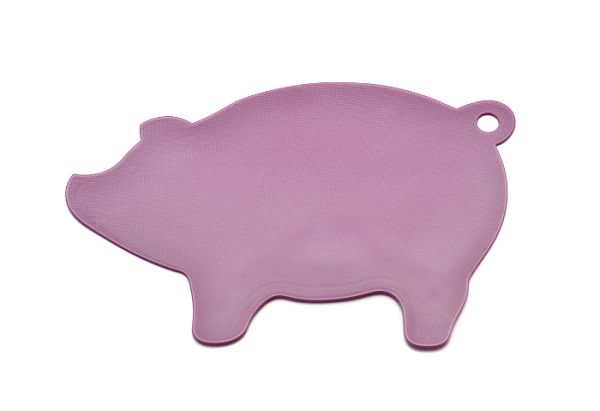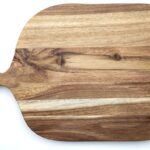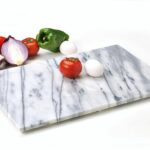A cutting board is an incredibly useful tool in any cook’s arsenal. Cutting boards provide a safe and clean place to cut meat and vegetables when preparing meals. Every kitchen has at least one, and it’s not uncommon to use multiple boards for different types of food.
Since cutting boards are used daily, the right board in your kitchen can make cutting and preparing food much easier.
Cutting boards can be made of different materials and each material has its advantages and disadvantages. Traditional wooden boards or eco-friendly bamboo boards can be bulky, especially if you have several different cutting boards. To last a long time, they require a lot of care. Glass cutting boards have a hard surface that can dull your knives quickly. Plastic boards are affordable and easy to clean but warp easily when washed in the dishwasher. Plastic boards are also not a good choice for hot dishes.

Related product: Liflicon Thick Silicone Cutting Board (Amazon)
What is so Special about Silicone Cutting Boards
Recent kitchen innovations include cutting boards made from food-grade silicone, also known as foldable cutting boards. These silicone boards can withstand temperatures between -40 and 260 °C and are more durable than plastic. They should offer customers the following advantages:
- Silicone is easy on knife edges: you want your knives to retain their strength and sharpness for as long as possible. They ensure that your best knives are not easily damaged by silicone. Marble, stone, steel, or glass can drastically shorten the life of your knives. Silicone creates a cushioned cutting mat surface that protects the knife edge. The silicone is an ideal surface to keep your kitchen knives in top condition.
- Flexible: Silicone cutting boards are flexible enough to fold. With this function, you can easily transport the staff to a pot or throw the garbage into the trash can. You can easily make a funnel and dump the chopped stuff directly into a frying pan or bowl. This reduces food spillage and makes storage easier.
- Bacteria resistant: High-quality silicone cutting boards have a non-porous, scratch-resistant surface that does not trap bacteria, ensuring safe and hygienic food preparation. Without proper cleaning, cutting boards harbor harmful bacteria and could lead to cross-contamination. You can clean and sanitize these in the dishwasher, reducing the risk of transmitting bacteria and foodborne illnesses.
- Easy to maintain. With these cutting boards, you can save the time you would spend on seasoning and disinfecting your old wooden cutting boards. They resist contact with water, so you can disinfect them with boiling water or in the dishwasher without fear of damaging them. Keep in mind that the dishwasher can clean the boards more effectively than hand washing, which is important because cutting boards come into contact with various foods.
- Hygienic: You can also eliminate harmful bacteria by sterilizing in the microwave. Rinse the board to remove excess food, roll up, and microwave at full power for 1 minute to create a sterile cutting surface for everyday, quick jobs. Silicone boards often have a juice groove that catches excess liquid from meat or fruit and prevents juices and blood from spilling onto the countertop.
- Slip-proof: Silicone has a non-slip surface that will not slip when cutting, even on smooth worktops. It grips onto the work surface and stays firmly in place during use, ensuring no accidents or messes.
- Eye-pleasing: Silicone cutting boards are usually available in attractive colors and can brighten up your kitchen. These boards are often color-coded and have symbols for each type of food. You can assign each color a different purpose to prevent food contamination.
- Convenient storage: The folding feature makes them easy to store away after use, which is especially convenient for small kitchens. They have a hole for hanging on a hook when not in use. This lightweight cutting board is easy to roll up and put in your picnic basket.
- Sturdy: Premium silicone cutting boards are extremely scratch-resistant and can withstand much wear and tear. They won’t bend or crack if you throw them in the dishwasher and leave them while they dry. They do not show signs of wear over time like those made of plastic or wood and never lose their shape.
Disadvantages of Silicone Cutting Boards
- Knife marks: The major downside is that the soft surface of silicone cutting boards is vulnerable to damage from knives. After using it for a couple of months, the boards will get knife marks. The silicone must be very durable to resist sharp knives. Some premium cutting boards are made of thicker and more knife-marks-resistant silicone.
- Plastic-like smell: These boards may smell like plastic right out of the box. It may take several washes for the initial smell to disappear. Before you use it, your new cutting board must be washed thoroughly by hand or in the dishwasher.
- Flexible: A flexible cutting board may be uncomfortable for some people who are used to a sturdier board.
- Prone to stains: The disadvantage is that silicone panels are not completely dirt-repellent. Certain foods, such as tomato juice and some spices, can leave stains that can be difficult to remove with simple washing.
- Retain smells: One of the negative aspects of silicone cutting boards is that they tend to retain food odors, especially after cutting a lot of onions.
Is Silicone Cutting Boards Worth Buying?
Silicone cutting boards are practical, versatile, and knife-friendly, and you can easily avoid cross-contamination. You just need to have several of them and use them for different purposes.
You don’t have to worry about seasoning or a complicated disinfection process. You can safely put these cutting boards in the dishwasher to ensure they are clean and sterile. Different colors and food symbols can significantly reduce the risk of cross-contamination. They are aesthetically pleasing and can enhance the look of your kitchen.
When choosing a cutting board, you should base it on your needs, kitchen space, and personal preferences. If you prefer a board that is easy to keep clean and disinfected, go for silicone. However, don’t expect them to last forever. You need to replace them with new ones from time to time. Over time they will get cut marks, but this also means that your knives are safe.
A good choice is a traditional wooden board for larger cutting jobs. In addition, it has multiple silicone cutting boards to handle different types of food and ensure a safe food preparation environment. This way you minimize the risk of cross-contamination.





Greetings! Very helpful advice within this article! It’s the little changes which will make the most significant changes. Many thanks for sharing!
I have those EXVI silicone cutting boards and was wondering about the microwave sterilization for them I have washed them by hand and in the dishwasher, so after washing by hand I have dried them and then put them in the microwave for 1 minute on high power here is my question does it matter if the cutting board is wet or dry when doing this which would be better.
I think that putting them slightly wet or completely dry doesn’t make a difference. The sterilization process definitely won’t damage a board. As you know, you shouldn’t place a bowl in a microwave without any water (food) in it, because this can be damaging for the appliance. I believe that sterilizing a dry, folded silicone board for a minute is not potentially harmful for a microwave. What other people have to say?
My microwave does NOT like to run dry! Also isn’t it the moisture in foods that the micro waves heat? I sterilize my sponges often in the micro and have found that putting them in quite wet means that I can heat them on hi for 2-3 mins. which seems to me a safer bet for killing germs than just 1 minute. I would suggest at least or also, put a cup of water in with your things. When I micro yak cheese doggie treats to puff them, they tended to scorch before they were done puffing. (That smells simply awful too!) So now I always wet them & if larger pieces, put a cup of water in as well.
I bought two of the Liflicon Thick Silicone Cutting Boards. Both have deep or thru cuts in the first week of using them. I use a Victorix 6″ paring knife and a Chicago Cutlery Chinese chef knife. I steeled both before using. Neither has been sharpened in months.